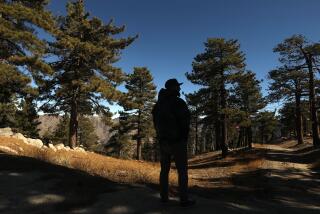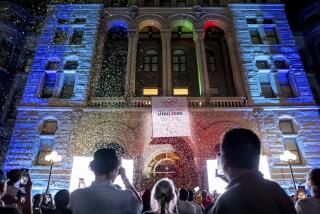These three Utah ski resorts aren’t just for locals anymore. Here’s why they will intrigue you
- Share via
Reporting from Ogden, Utah — For several days during the 2002 Winter Olympics, Snowbasin Resort had its encounter with fame when it hosted the world’s fastest ski racers in the downhill, combined and Super G events.
What television watchers and on-hill viewers saw at Snowbasin, on the east side of the Wasatch Range about 20 miles from Ogden, was a top-notch ski hill. That was thanks to the Holding family, which also owns Idaho’s Sun Valley resort and had invested millions to build three stunning day lodges and a lift system with six chairlifts, two gondolas and a tram.
Snowbasin faded from the skiing and snowboarding public’s radar, even though it’s only about 10 miles farther from the Salt Lake City airport than the state’s better-known Park City, Snowbird, Alta and Deer Valley resorts.
But Snowbasin is still here. Its 3,000 acres of both challenging and mellow terrain is one of the West’s best-kept secrets.
What it lacks in on-slope lodging and nightlife, it more than makes up for with its 3,000-foot vertical drop, six distinct peaks, four terrain parks, numerous bowls and about 16 miles of cross-country ski trails.
Because it’s not as well known, the lift lines are shorter. Once skiers and snowboarders head up the Strawberry Gondola, they find they often have big sections of the mountain to themselves.
When my oldest son, Matt, and I visited Snowbasin in the spring, I wanted to check out the men’s downhill course, where racers can reach speeds of more than 75 mph.
After skiing all morning and dining on the outdoor deck of the John Paul Lodge, we rode up the 15-passenger Allen Peak Tram — which locals call the “Beer Can” because of its shape — to the top of the course.
From that perch at nearly 9,500 feet, we had stunning views of the Wasatch Range, the Ogden Valley and the Great Salt Lake.
Almost directly below us were the steep Grizzly (men’s) and Wildflower (women’s) downhill runs. Both courses were designed by former Swiss ski racer Bernhard Russi and are some of the toughest Olympic courses on the globe.
I gulped as I sized them up, then decided to find an easier way down.
Nonskiers can also ride to the top of Allen Peak for the views, using the John Paul Express quad chair and the tram. Rates are $12 during the week and $15 on weekends.
We skied all over the mountain the rest of the afternoon, cruising on some of the long intermediate runs off the Strawberry Gondola and the Middle Bowl triple chair as our legs tired.
That evening, we dined in front of a big fireplace at Earl’s Lodge at the base of the mountain. We feasted on one of the chef’s special culinary expeditions, this one called Taste of the Islands that included curried goat, ono escabeche, Jamaican jerked chicken legs, Kalua pork and fried conch with pineapple slaw and tartar sauce.
Though Snowbasin was the highlight of our Ogden-focused trip, we were curious about Nordic Valley, which has 140 acres of skiable terrain, and Powder Mountain Resort, which covers 8,464 acres.
Nordic Valley draws mostly locals, but for skiers and snowboarders flying into Salt Lake City in the afternoon and eager to get on the snow, it’s worth checking out because it has the Ogden region’s only night skiing. It also has a repurposed barn as its lodge, which appealed to me as a Wisconsin resident.
Powder Mountain, which added two new lifts this season, is Snowbasin’s somewhat rustic and funky cousin.
But its expansive slopes, bowls, steeps and low skier density (capped this year at 2,000 lift tickets a day) make it popular with adventurous skiers and boarders who live in the area.
It also has on-slope lodging, which means you can step out your front door and hit the snow.
If the 144 named runs on “Pow-Mow’s” 3,800 lift-served acres aren’t enough, visitors can hop on a Lightning Ridge snowcat for access to the steep and untouched (except for your fellow snowcat passengers) Shug’r Bowl.
Intermediates who want their own fresh powder should try Cobabe Canyon, which is also served by snowcats. A single-ride pass for both snowcat tours is $20. A full day’s Powder Expedition into untracked terrain is $440per person.
Skiers and boarders also can book inbound guided tours that start at $165 for a half-day, or sign up for a back-country expedition to powder in the DMI and Wolf Creek areas. These back-country tours ($325 for a full day, $200 for a half-day) may include lifts, snowcat, snowmobile and shuttle.
Those who’d like to take a snowcat ride can sign up for a sunset alfresco dinner trip to a lofty perch with views of the Ogden Valley and the Wasatch and Uinta mountains. Prices are $80 for adults and $32 for children.
If you go
THE BEST WAY TO SALT LAKE CITY
From LAX: Delta, Southwest, American and United offer nonstop service to Salt Lake City, and Southwest, Alaska, Delta and American offer connecting service (change of planes). Restricted round-trip airfare from $195, including taxes and fees. Snowbasin, Powder Mountain and Nordic Valley are all about 50 miles from the Salt Lake City airport.
By presenting their boarding pass at the lift-ticket window, skiers and snowboarders who fly on Alaska Airlines can get a free day of skiing at Snowbasin if they arrive Mondays through Wednesdays.
Another good option is the $145 Ski Three Pass for visitors who stay two or more nights in Ogden. The pass gives access to Nordic Valley, Powder Mountain and Snowbasin.
More to Read
Sign up for The Wild
We’ll help you find the best places to hike, bike and run, as well as the perfect silent spots for meditation and yoga.
You may occasionally receive promotional content from the Los Angeles Times.






